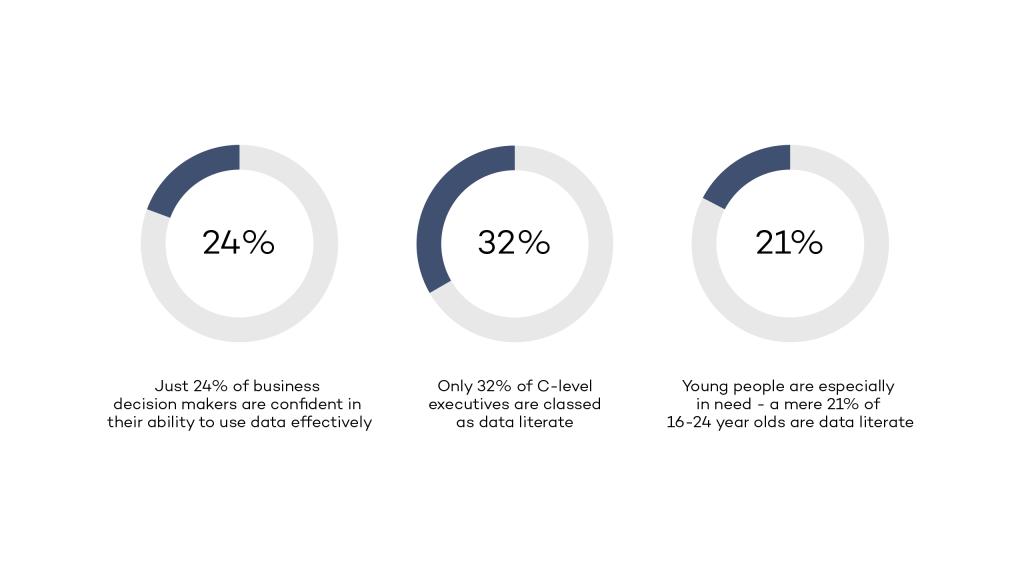
Data literacy is the new citizenship skill
Data literacy is the new citizenship skill
Automation, augmented intelligence (AI), and machine learning are shaping working life at an accelerating pace, bringing forth fresh challenges for both people and businesses. It's crucial to keep up with the global market and maintain relevant expertise for the road ahead. In the current era, awash with data, a business' ability to thrive hinges on how to turn data into groundbreaking insights. The key to this is data literacy.
Changes in working life: digitalisation and the growth of data
No one knows for sure what skills will be needed in the future. However, the amount of data is constantly increasing, which is why understanding it is important. Data literacy is already comparable to reading and writing skills, and it will become even more emphasised in the future. Data literacy is also about equality: operating in a changing world requires new kinds of tools that facilitate engagement in society and within the professional realm. Clear gaps in skills can already be seen, which is connected to a wider discussion about the differences between generations in digital skill levels.
Digitalisation has already revolutionised working life by allowing for automation, real-time data analysis, and seamless virtual collaborations. Now generative AI is taking digitalisation to the next plateau, by not just processing information but creating new content that can fill gaps, answer queries, or propose solutions. The best part is that everyone can access to the tools like ChatGPT with a minimal understanding.
What is data literacy?
According to MIT's Rahul Bhargava and Emerson College's Catherine D'Ignazio (2015), data literacy means the ability to "read, work with, analyse and communicate with data”. It's a skill that equips employees across an organisation to effectively query data and technology, enhance their understanding, make decisions, and convey insights to others.
When talking about data literacy, we often refer to an individual person, but it can also be seen to apply more broadly to an entire organisation. In this case, data literacy additionally includes the utilisation of data in decision-making and the availability of that data to employees across all organisational levels. It requires an investment from the organisation to ensure that workplace culture and management methods don’t create obstacles to flexible learning.
Still, companies may not yet know how to use data in a way that would support decision-making and business operations. According to a report by Qlik, only 24% of business decision makers are confident in their ability to use data effectively, and only 32% of C-level executives are classed as data literate. (Qlik 2021.)

How to get started in developing data literacy?
It all starts with creating a data and analytics strategy and choosing an analytics partner that can support the whole process, technologies, analytics environments, as well as training. Here are our 5 tips in working towards more data literate people and culture:
Create a data and analytics strategy that permeates all aspects of business. The main goal of a strategy is to unlock the full potential of data within an organisation. This involves aligning business objectives with data initiatives, building a robust infrastructure for managing and analysing data, and supporting a culture that values data-driven decision making.
Secure access to analytics tools that facilitate daily work by modifying data into an easily understandable format. Data tools, such as Qlik Sense or Power BI package and visualise data in an accessible format that does not require a master's degree in data science or to be an analytics wizard to understand it. It’s sufficient to understand the basics and know how to apply the knowledge in practice. For example, the Qlik Sense based Fortum Lens solution, previously implemented by Fortum and AFRY, has brought transparency and timeliness to support Fortum's operating culture and decision-making.
Democratise data by giving employees access to the data that is central to their work. With the help of certain analytics solutions, data collected and produced by the company is more transparent than before and truly useful, because with it, each business unit of the company can receive information relevant to itself. In terms of the development of data literacy, it is essential that data is available to all people in the organisation, albeit with different emphasis.
- Train employees on data literacy and how to use company’s analytics solutions (see more on next chapter).
- Hire new data-literate employees who will gradually take the company towards a more data-driven direction.

Practice makes the master
Introducing new analytics tools needs to be accompanied by training to support their use. Employee data literacy will not improve automatically just by adding tools if they don’t know how to use them. When choosing an analytics partner, you should always pay attention to whether the partner offers a comprehensive and business-oriented introduction to the solutions it delivers, as well as change management support. In addition to a guided workshop, the training should include basic information about data and the analytics solution in practice, depending on the starting level of the group.
It is equally important to get employees motivated and to understand why the solution has been implemented and what it means in terms of doing their own work. Company leadership must have the principles of change management firmly in their hands, so that the process remains under control and the employees can be committed to new ways of working. This is optimally accomplished when a company's management understands how the solution can be swiftly integrated into the daily operations across various employee
Implementation is successful when the company considers the various starting levels of employees in relation to data and invests in clear and open communication. Employees should also be attracted to the change, as the company's data literacy grows through employees who are enthusiastic and interested in developing their own work, who genuinely want to increase data controllability in all company operations. Although the company's data literacy is not entirely the sum of the employees' data literacy, the importance of competent and committed employees is undeniable. When data democratisation and open communication are added to the equation, the company's recipe for success in data literacy is guaranteed.

References
D’Ignazio, C., & Bhargava, R. (2015). Approaches to Building Big Data Literacy. In Bloomberg Data for Good Exchange 2015. New York, NY, USA. https://www.media.mit.edu/publications/approaches-to-building-big-data-literacy/
Qlik (2021). Empower Your Organization to Speak Data. https://res.cloudinary.com/talend/image/upload/v1711497833/qlik/docs/resource-library/datasheets/resource-ds-data-literacy-program-datasheet-en_qeydht.pdf


